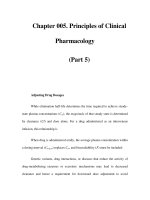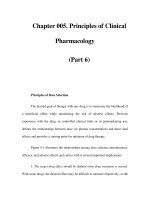Chapter 105. Malignancies of Lymphoid Cells (Part 5) pdf
Bạn đang xem bản rút gọn của tài liệu. Xem và tải ngay bản đầy đủ của tài liệu tại đây (66.07 KB, 5 trang )
Chapter 105. Malignancies of
Lymphoid Cells
(Part 5)
Table 105-
5 Diseases or Exposures Associated with Increased Risk of
Development of Malignant Lymphoma
Inherited immunodeficiency disease
Klinefelter's syndrome
Chédiak-Higashi syndrome
Ataxia telangiectasia syndrome
Wiscott-Aldrich syndrome
Common variable immunodeficiency disease
Acquired immunodeficiency diseases
Iatrogenic immunosuppression
HIV-1 infection
Acquired hypogammaglobulinemia
Autoimmune disease
Sjögren's syndrome
Celiac sprue
Rheumatoid arthritis and systemic lupus erythematosus
Chemical or drug exposures
Phenytoin
Dioxin, phenoxyherbicides
Radiation
Prior chemotherapy and radiation therapy
Immunology
All lymphoid cells are derived from a common hematopoietic progenitor
that gives rise to lymphoid, myeloid, erythroid, monocyte, and megakaryocyte
lineages. Through the ordered and sequential activation of a series of transcription
factors, the cell first becomes committed to the lymphoid lineage and then gives
rise to B and T cells. About 75% of all lymphoid leukemias and 90% of all
lymphomas are of B cell origin. A cell becomes committed to B cell development
when it begins to rearrange its immunoglobulin genes. The sequence of cellular
changes, including changes in cell-surface phenotype, that characterizes normal B
cell development is shown in Fig. 105-2. A cell becomes committed to T cell
differentiation upon migration to the thymus and rearrangement of T cell antigen
receptor genes. The sequence of the events that characterize T cell development is
depicted in Fig. 105-3.
Figure 105-2
Pathway of normal B cell differentiation and relationship t
o B cell
lymphomas. HLA-
DR, CD10, CD19, CD20, CD21, CD22, CD5, and CD38 are
cell markers used to distinguish stages of development. Terminal transferase
(TdT) is a cellular enzyme. Immunoglobulin heavy chain gene rearrangement
(HCR) and light chain gene rearrangement or delet
ion (κR or D, λR or D) occur
early in B cell development. The approximate normal stage of differentiation
associated with particular lymphomas is shown. ALL, acute lymphoid leukemia;
CLL, chronic lymphoid leukemia; SL, small lymphocytic lymphoma.









